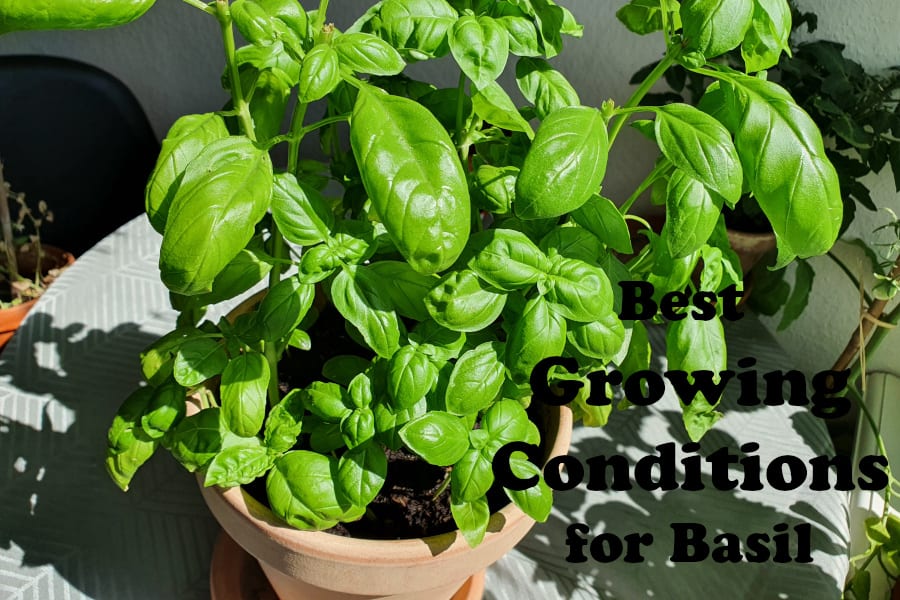
The most important thing to know about when growing basil is how to give the plants the best growing conditions. If basil plants have the right conditions, they will reward you with bountiful harvests and lots of growth and production, but what are the best growing conditions for basil actually? See this table I have made to give you a quick overview. I cover each point in detail and share some great tips below.
| Sunlight | 6-8 hours per day. |
| Temperature | 70-85°F (about 21-29°C) is ideal. Minimum is 50°F (10°C), and maximum is 90°F (32°C). |
| Watering | When the top of the soil is dry (usually every 1-2 days). |
| Soil type | Nutrient-rich and well-drained, sandy soil. The soil should be moist and never soaked or dry. |
| Soil pH | 6.0-7.5. |
| Fertilizer | Fertilize sparingly. Mix a liquid 5-10-5 fertilizer into the water every 4-6 weeks. |
| Spacing | In a pot: 3-5 plants per 8-inch (20 cm) pot. In the ground: 3-5 plants together per group in the ground with 12 inches (30 cm) between groups. |
This table is great as a general guideline for how to care for your basil, but I have a bunch of great tips and tricks about each of the points that can make your plants grow even better. I share all of them in this article, so keep reading if you want to know more.
Best Amount of Sunlight for Basil (And More Tips)
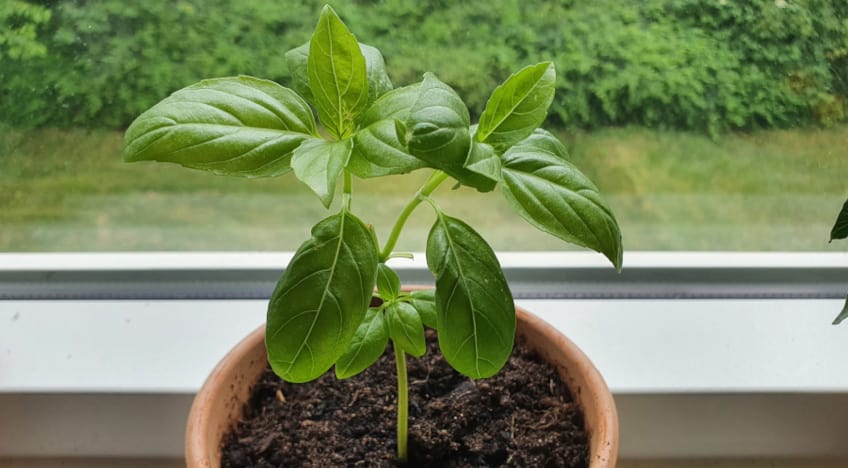
As a Mediterranean herb, basil naturally loves sunlight and needs a lot of it to thrive, but it can also get too much, so you need to hit the sweet spot. When basil plants get too little sunlight, they grow much slower or perhaps not at all, and if they get too much, they begin to wilt, the leaves begin to turn yellow and brown, and the plant will eventually dry out and die (read more).
So, how much sunlight does basil need?
Basil plants need 6-8 hours of sunlight per day on average. However, since the intensity of the sunlight that reaches the plant changes throughout the season, 8-9 hours in the spring and fall and 5-7 in the middle of the summer is ideal.
If possible, it is a really good idea to plant your basil somewhere it can get the sunlight it needs in the morning and early afternoon and be shaded in the late afternoon and evening. This is because the intensity of the sunlight changes throughout the day, and it can be a bit too intense for basil plants later in the afternoon which can potentially damage the plants (read more).
Best Temperature for Basil (Plus Lowest and Highest)
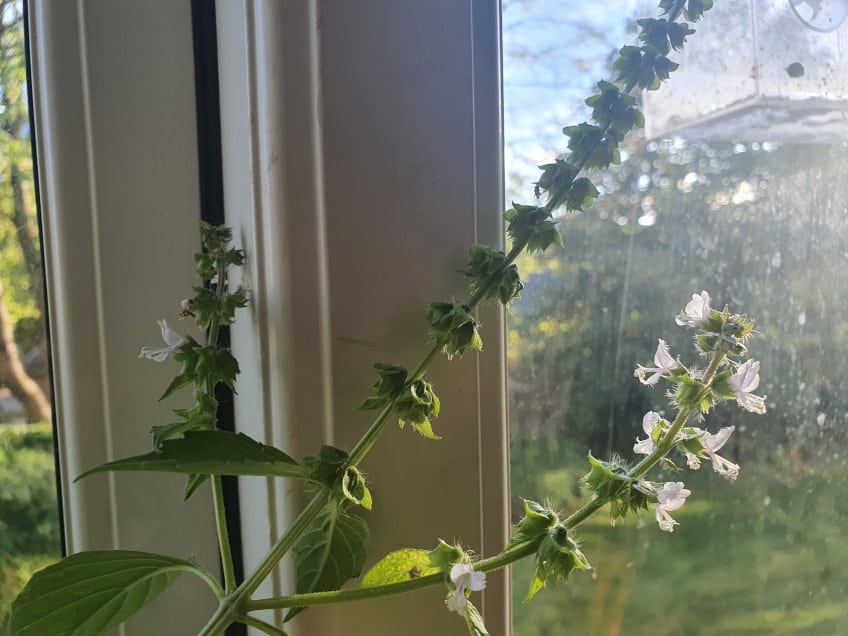
The temperature has a massive impact on how well basil plants grow. If it is too cold, basil plants grow really slowly or perhaps not at all, and if it is too warm, they begin to flower too early.
If you, like me, are growing basil primarily to harvest and eat the leaves, you want your plants to be as productive as possible and to stay in the growing stage without entering the flowering stage for as long as possible, and the temperature affects that a lot, so what is the ideal temperature for growing basil?
Basil grows best and is most productive at temperatures between 70-85°F (21-29°C). They can grow at temperatures between 50°F (10°C) and 90°F (32°C), although they grow slower the lower the temperature is and flower faster, the higher it is.
It is easy to keep track of the temperature with a good thermometer. I couldn’t find the specific one I have online since it is relatively old but this one from Amazon is very similar. I especially like that it shows both Celsius and Fahrenheit.
If you like to grow basil in a pot indoors, you don’t have to worry too much about the temperature. I do that every year, and it grows really well at room temperature. But I highly recommend placing your basil next to a window that gets a lot of sunlight if you grow it indoors as it usually heats the plant and the soil a little extra, which is really good for the plant.
Best Way to Water Basil (How, How Much, and How Often)
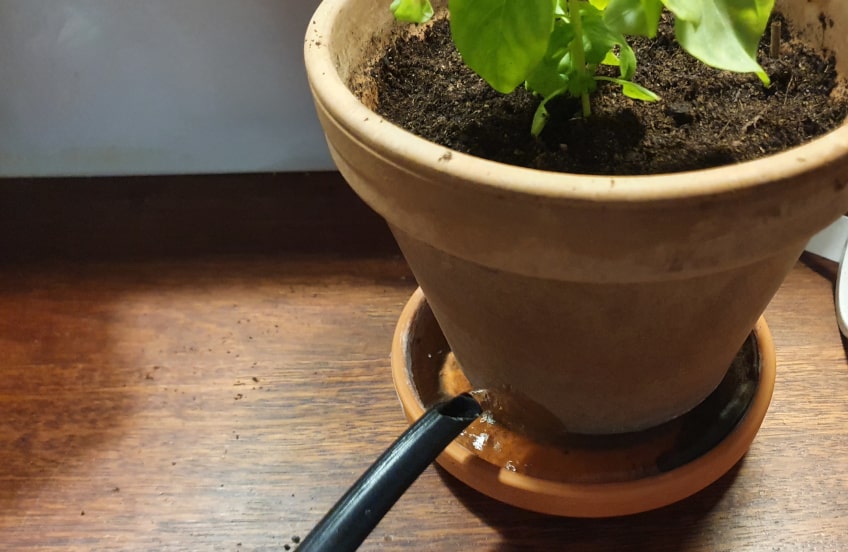
Proper watering is a crucial part of growing basil. It is really not that hard once you know how to do it, but if you don’t, you can quickly end up damaging or even killing your plants by giving them too much or too little water.
So, how much water should basil get, and what is the best method?
The best way to tell if a basil plant needs water is to lightly touch the top of the soil. If it is dry, then water the plant. The soil should stay moist and never be soaked or dry. If possible, water basil by pouring water into the plate underneath the plant as it promotes root growth.
Of course, you can only water from the bottom if you grow your basil in pots with a drainage hole at the bottom and a plate underneath. I always use and recommend such pots as you can see in many of my photos on my website. I especially like terra cotta pots such as these from Amazon since they are great for keeping the soil healthy.
Watering basil by pouring water into the plate underneath the plant (like in the photo above) is also called bottom-watering. It is a really good way to encourage the plant’s roots to grow since they have to seek out the water, so if possible, bottom-water your basil plants (read more). If they grow in the ground, just pour the water on the soil, but try to avoid getting it on the leaves as it can damage them if you’re unlucky.
You can find my complete guide to watering basil on this link.
Best Soil for Basil (Nutrients, Drainage, pH, and More)
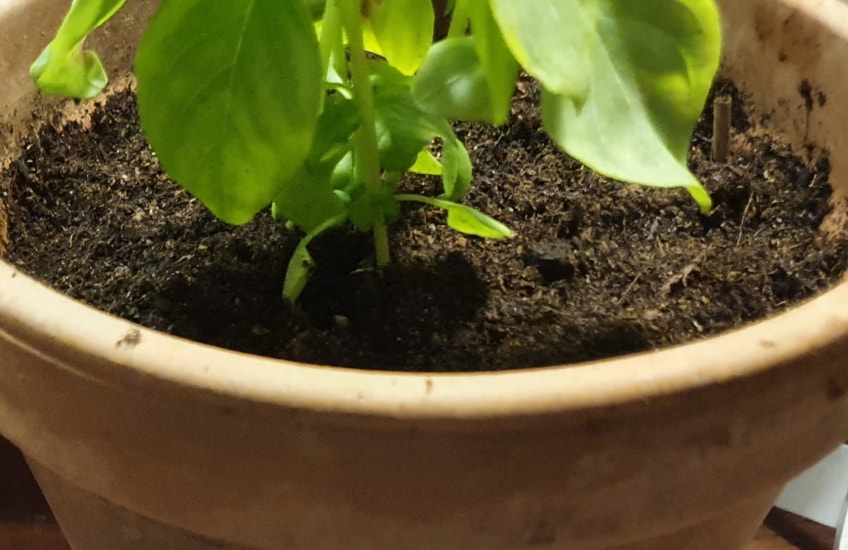
Using the correct type of soil can make a huge difference in how well your basil plants grow and how productive they are. If the soil has too little nutrition for the plants, they will grow slowly, and if it has too much clay, the roots can’t grow and spread properly, which also inhibits growth.
So what is the best soil for growing basil?
Basil grows best in nutrient-rich, well-drained soil with a pH of 6.0-7.5. For a good mix, use a good, nutrient-rich potting mix with a lot of organic matter and mix about 20-30% sand into it to improve drainage and root growth. Mixing some compost into the soil will improve it further.
If making your own soil mix seems a bit too intimidating right now, that’s totally fine. Just get a bag of some good, preferably organic, potting soil and use that. I did that for a very long time, and it worked really well too, but if you’re up for a challenge, I recommend trying mixing in some sand and compost as I recommended above.
You should also remember that the soil should stay moist and never be completely soaked or dry for basil to grow best.
Best Fertilizer for Basil (And How Often to Use It)
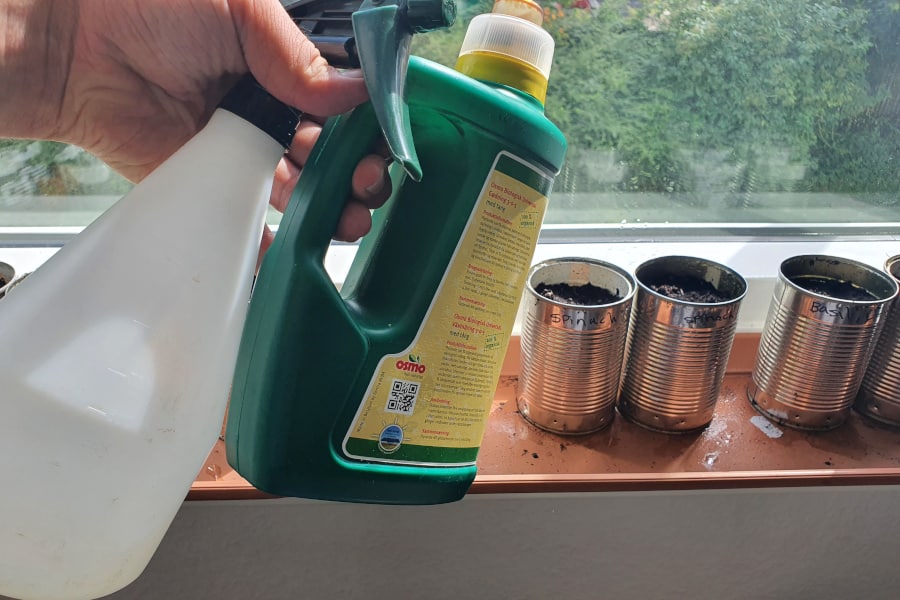
Basil can actually grow quite well without any fertilizer. Especially if you use some good, nutrient-rich soil, but even so, using some fertilizer once in a while can still improve your plants’ growth and productivity.
So what is the best fertilizer for basil, and how often should you use it?
The best fertilizer for basil is an organic, liquid fertilizer with a 5-10-5 NPK value. Mix about half of the recommended dose of fertilizer into the water for the plants once every 4-6 weeks for the best results according to the University of Minnesota.
I have tested a couple of different fertilizers for basil over the years, and for a long time, I just used an organic, liquid, all-round fertilizer for garden plants, and it honestly worked really well. If you’re not sure about how to find a fertilizer with the correct NPK values, I recommend going to a garden center or a nursery and asking about it, but otherwise, just get an all-around fertilizer for vegetables, as that will work fine too.
If you use fertilizer on your basil plants (and I recommend that you do), you should know how to tell if your plants are being overfertilized as that can damage and potentially even kill them. If a basil plant is being overfertilized, its leaves will begin to curl and turn brown.
How Much Space Does Basil Need? (Potted and in the Ground)
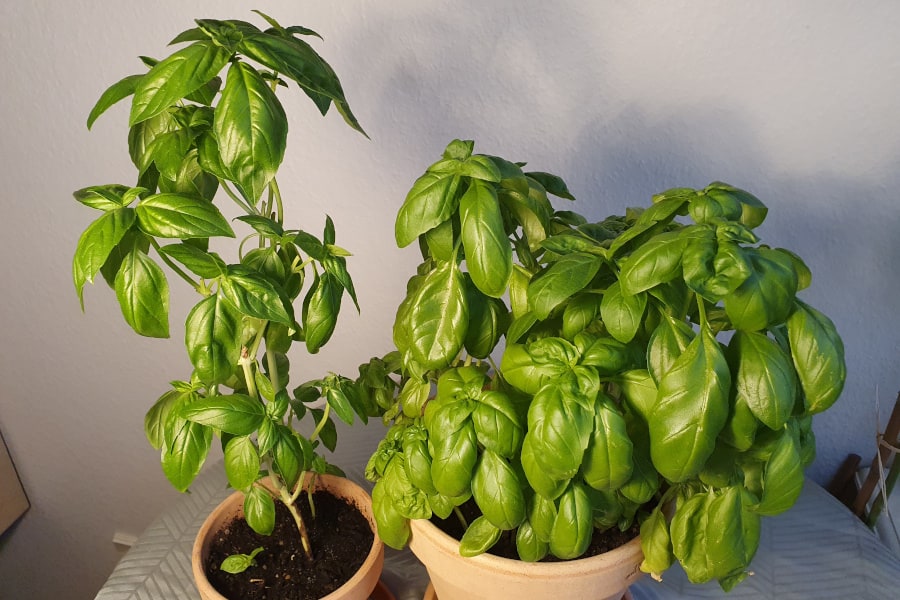
If basil plants don’t have enough soil to grow in, they will end up getting rootbound which puts their growth to a stop if it is not taken care of. Additionally, if they don’t have enough room to grow above ground, the plant will start to grow slower and slower and become more and more crowded, which increases the risk of mold and diseases.
So how much space should basil plants have?
It is best to grow basil in groups of 3-5 plants with 12 inches (30 cm) of space between each group. For potted basil, 3-5 plants in an 8-inch (20 cm) pot is best. You can also sow basil seeds much more densely for large harvests, although each plant will not get as big.
I actually really like the second method I mentioned. Sowing basil seeds really liberally. It gives a huge, dense basil bush, but of course, each plant doesn’t get as big since it doesn’t have so much room to grow.
I always grow basil in a couple of different ways, such as one or a few seeds together or 20-30 seeds in a single pot, just because I like to see the difference. If you sow many seeds together, you might have to add some fertilizer once in a while since the plants will quickly use what is in the soil.
The key takeaway for you is that you should just decide how you prefer to grow your plants. Generally speaking, the more space your plants have, the larger they can get and the faster they can grow.
The photo above is of a basil plant I bought in a supermarket, and as you can see, there are 10-15 plants or so in a tiny pot. That does not work for a very long time as the plants quickly become rootbound, which means there is no more room for the roots to grow, which makes the plant stop growing.
I have also written an article where I explain why it is so important that plants have enough space and what happens if they don’t. If you are interested in that, you can find that article here.
Read My Complete Guide to Growing and Caring for Basil
I have written a thorough guide where I cover all parts of growing your own basil including choosing a variety, sowing the seeds, the best growing conditions, pruning, propagation, harvesting, storing, solving various problems, and a lot more. You can find the article on this link.

